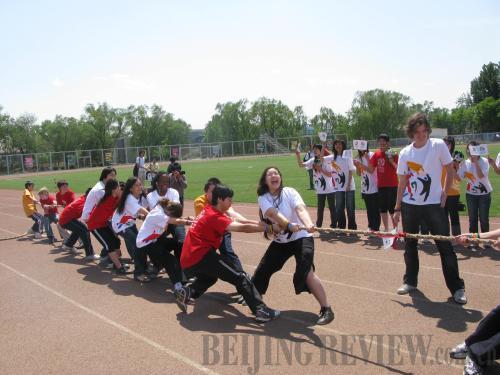|
 |
|
PULLING HARD: international students of Beijing No. 55 Middle School in a tug-of-war (COURTESY OF BEIJING NO.55 MIDDLE SCHOOL) |
As more foreigners move to China, expat parents are faced with important decisions about a child's education. High academic standards, diverse learning environments, affordable tuition, and the chance for their children to be immersed in local culture have more families choosing Chinese public schools over their international counterparts.
Beijing Fangcaodi International School
In 1956, Beijing's Fangcaodi International School became the first Chinese public primary school to enroll foreign students. The school was initially founded to provide quality education to the children of foreign diplomats. It has taught 4,000 foreign students from more than 150 countries and regions. Many are children of diplomats, experts and business people living in Beijing.
The school features Chinese language teaching, and all lessons except English are taught in Mandarin. "Children learn the language best when you teach what they can use every day. As the [Chinese language] curriculum is designed to arouse their interest, they pick up the language when playing games and drawing pictures," Chen Xin, an experienced Mandarin teacher, told ChinAfrica.
Various courses featuring traditional Chinese culture are another highlight. They include diabolo, kungfu, calligraphy, Chinese painting, Peking opera, paper-cutting, knitting and folk dances. "I took the diabolo, [because] I saw many Chinese seniors playing them in the morning. It was really a lot fun," said 11-year-old Guinean Kadia Sacko.
Foreign and local students are integrated in many classes and activities. Upon graduation, students are prepared for life beyond Beijing. "The school not only gave me an early grasp of Chinese, but also equipped me with discipline and ambition, assets which have proved invaluable in recent years," said Rebecca MacKinnon, an American former student who is now on the Board of Directors of the Global Network Initiative and the Committee to Protect Journalists.
At present, there are 758 overseas students from 60 countries and regions in Fangcaodi's international department, including around 10 African children from Egypt, Guinea-Bissau, Mauritius, Cameroon, Angola and the Democratic Republic of Congo, according to the school.
|